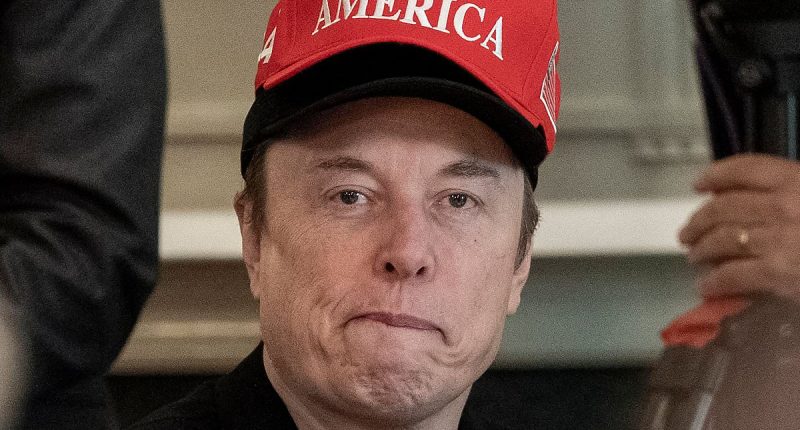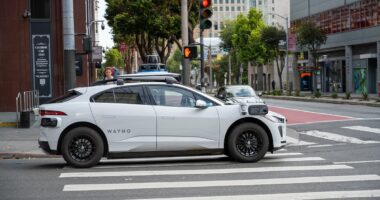Share this @internewscast.com
Elon Musk is again calling for NASA to scuttle the International Space Station (ISS) after a former engineer of the agency revealed hidden problems with its structure.
Casey Handmer, a physicist and engineer who worked at NASA’s Jet Propulsion Laboratory (JPL) for four years, posted on X that the 26-year-old station’s structure integrity is far worse than the public knows.
‘We could wake up tomorrow and find, with zero warning, that it has failed catastrophically,’ Handmer warned on X Thursday.
Musk, the CEO of SpaceX, quickly responded, saying that even though his commercial space company makes billions from delivering cargo and astronauts to the station, it should be brought down by 2027.
‘There are potentially serious concerns about the long-term safety of the [ISS]. Some parts of it are simply getting too old and obviously that risk grows over time,’ Musk posted early Friday morning.
The renewed push to decommission ISS came hours after NASA delayed a private astronaut mission by Axiom Space Inc because of a pressure leak in one of the station’s Russian-built sections, meaning there could be less air to breathe.
The billionaire leader of SpaceX, Tesla, and X has been calling for NASA to scrap the $150 billion project since February.
At the time, Musk was also the head of the Department of Government Efficiency (DOGE) and recommended to President Trump that the station be brought down ‘as soon as possible.’

The International Space Station is now 26 years-old and has suffered multiple pressure leaks in recent years, prompting Elon Musk to call for its retirement by 2027

Casey Handmer, a physicist and engineer who worked at NASA for 4 years, warned that the International Space Station has more structural problems than are being reported publicly
In his post, Handmer warned that these leaks are becoming more frequent and taking place in multiple sections of the ISS.
He added that as the station’s aluminum shell flexes, the metal fatigues and gets harder, which increases the risk of it cracking.
The former NASA employees revealed that ‘multiple cracks have been discovered,’ even though none of these pressurized sections were meant to crack.
First launched in November 1998, the ISS is nearing the end of its operational lifespan and has been showing signs of wear and tear for years.
Last November, another leak in the Russian segment that had been worsening for five years sparked fears that the astronauts on board may need to evacuate, causing NASA to warn that this could lead to a ‘catastrophic failure’ of the space station.
Astronauts have been patching the leak and keeping the module it’s located in mostly sealed off to eliminate any immediate threat to their safety.
The new issue this month emerged shortly before the launch of Axiom Mission 4, a private spaceflight to the ISS operated by Axiom Space, in partnership with SpaceX and NASA.
The mission was set to deliver four astronauts to the ISS for a 14-day stay. The crew aimed to conduct approximately 60 scientific studies, focusing on microgravity research in technology, life sciences, and other fields.
In a statement, NASA said that a new launch date has not been scheduled as the investigation into the pressure leak continues.

Elon Musk responded to Casey Handmer’s comments on X, saying that he is ‘going on the record’ as saying that the International Space Station needs to be deorbited within 2 years

The ISS is nearing the end of its operational lifespan and is showing signs of wear and tear from collisions with various space objects. The Canadarm2 robot arm (pictured) was struck by space debris in May 2021, creating a hole that fortunately didn’t impact its functionality

NASA has awarded $843 million to Elon Musk’s SpaceX to build the spacecraft which will help the International Space Station deorbit. The scheduled year for this mission is still 2030
The growing list of alarming maintenance issues are partly what drove NASA and its ISS partners – Russia, Japan, Canada, and 11 European countries – to make plans to retire the ISS by 2030.
However, Musk declared on Friday that he ‘would like to go on record recommending that it be de-orbited within 2 years.’
Musk’s SpaceX was tasked with building the spacecraft that would assist in the deorbiting of the station.
In June 2024, NASA awarded SpaceX a $843 million contract to build the deorbit vehicle, or USDV, that will be used to safely guide the ISS back into the Pacific Ocean in 2030.
That being said, decommissioning the ISS ahead of schedule is not that simple and would require agreement from all the space station’s partners, not just the approval of President Trump.
Trump could propose shutting down the space station before 2030, but in addition to getting the other ISS partners on board, funding for the deorbit mission has to come from Congress.
Moreover, the SpaceX contract only covers the cost of building the USDV, not the entire deorbit mission. Last summer, former NASA Administrator Bill Nelson was seeking $1.5 billion from the US government to cover the entire project.






